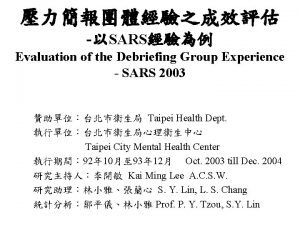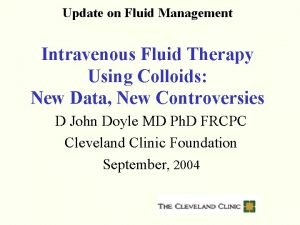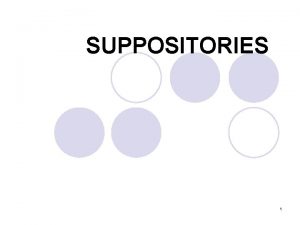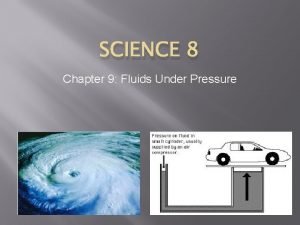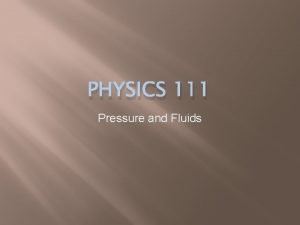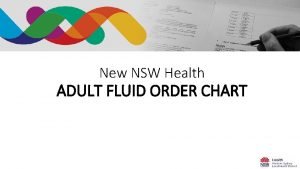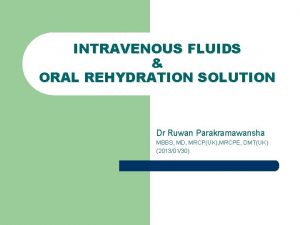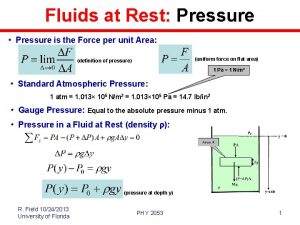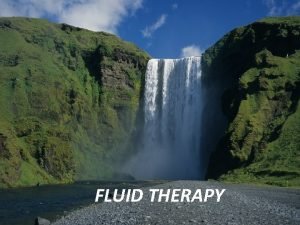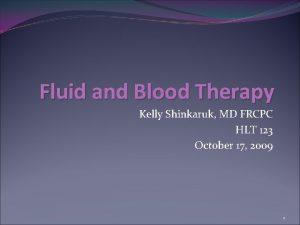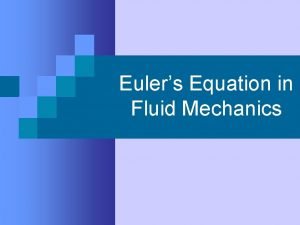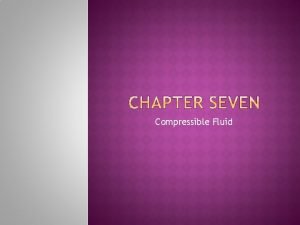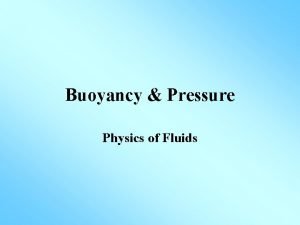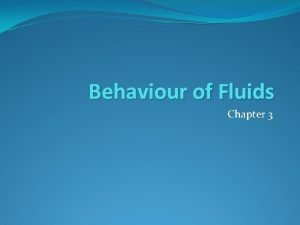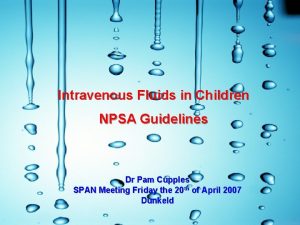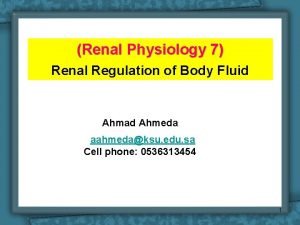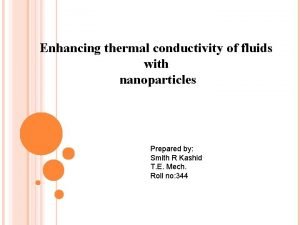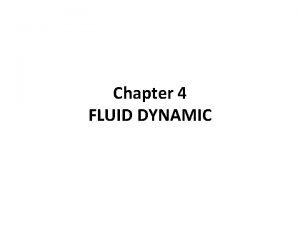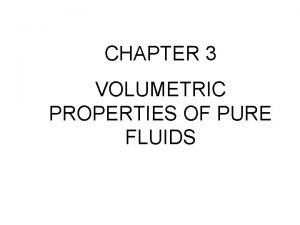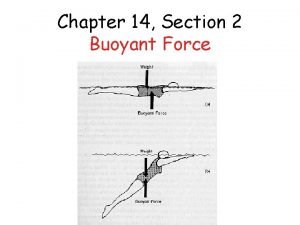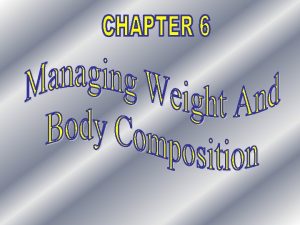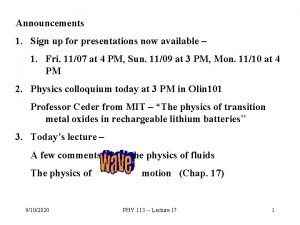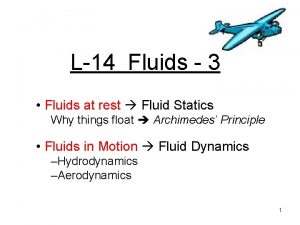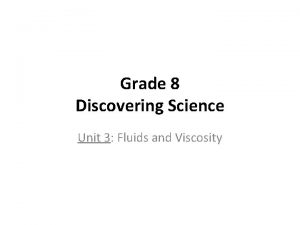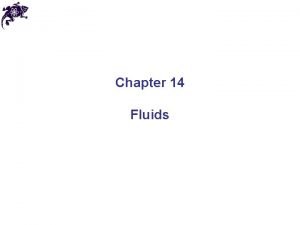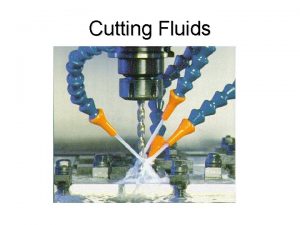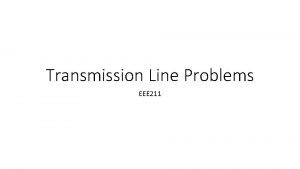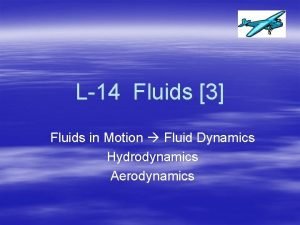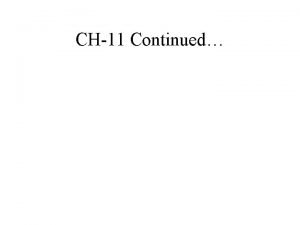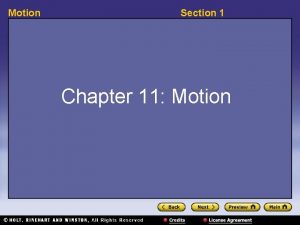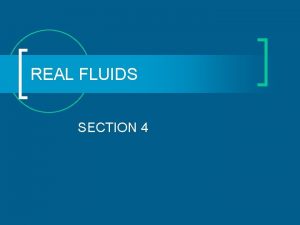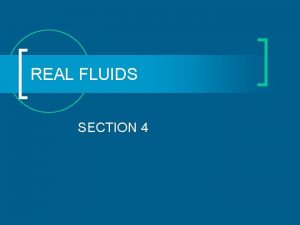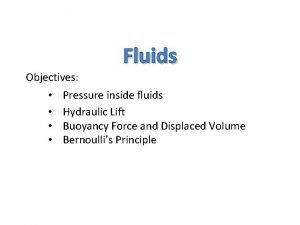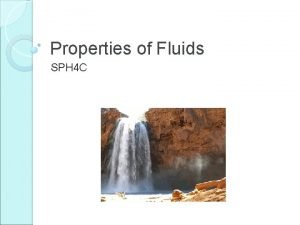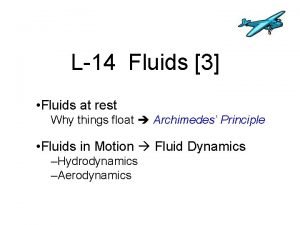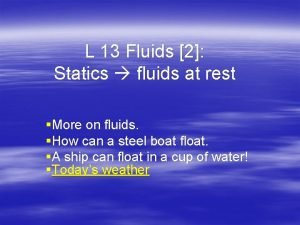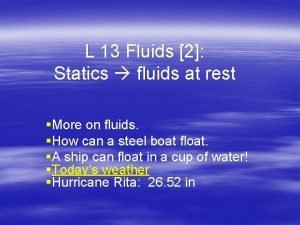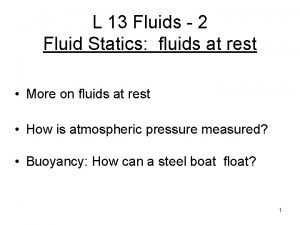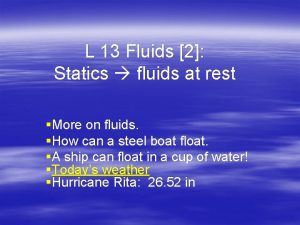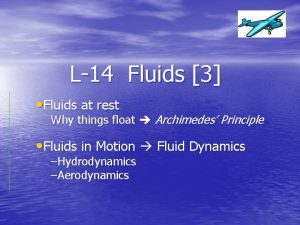Section 13 5 Fluids in Motion cont 2015










































- Slides: 42

Section 13. 5 Fluids in Motion (cont. ) © 2015 Pearson Education, Inc.

Fluids in Motion For fluid dynamics we use a simplified model of an ideal fluid. We assume 1. The fluid is incompressible. This is a very good assumption for liquids, but it also holds reasonably well for a moving gas, such as air. For instance, even when a 100 mph wind slams into a wall, its density changes by only about 1%. 2. The flow is steady. That is, the fluid velocity at each point in the fluid is constant; it does not fluctuate or change with time. Flow under these conditions is called laminar flow, and it is distinguished from turbulent flow. 3. The fluid is nonviscous. Water flows much more easily than cold pancake syrup because the syrup is a very viscous liquid. Viscosity is resistance to flow, and assuming a fluid is nonviscous is analogous to assuming the motion of a particle is frictionless. Gases have very low viscosity, and even many liquids are well approximated as being nonviscous. © 2015 Pearson Education, Inc. Slide 13 -2

The Equation of Continuity • When an incompressible fluid enters a tube, an equal volume of the fluid must leave the tube. • The velocity of the molecules will change with different cross-section areas of the tube. ΔV 1 = A 1 Δx 1 = A 1 v 1 Δt = ΔV 2 = A 2 Δx 2 = A 2 v 2 Δt © 2015 Pearson Education, Inc. Slide 13 -3

The Equation of Continuity • Dividing both sides of the previous equation by Δt gives the equation of continuity: • The volume of an incompressible fluid entering one part of a tube or pipe must be matched by an equal volume leaving downstream. • A consequence of the equation of continuity is that flow is faster in narrower parts of a tube, slower in wider parts. © 2015 Pearson Education, Inc. Slide 13 -4

The Equation of Continuity • The rate at which fluid flows through a tube (volume per second) is called the volume flow rate Q. The SI units of Q are m 3/s. • Another way to express the meaning of the equation of continuity is to say that the volume flow rate is constant at all points in the tube. © 2015 Pearson Education, Inc. Slide 13 -5

Quick. Check 13. 10 Water flows from left to right through this pipe. What can you say about the speed of the water at points 1 and 2? A. v 1 > v 2 B. v 1 = v 2 C. v 1< v 2 © 2015 Pearson Education, Inc. Slide 13 -6

Quick. Check 13. 10 Water flows from left to right through this pipe. What can you say about the speed of the water at points 1 and 2? A. v 1 > v 2 B. v 1 = v 2 C. v 1< v 2 Continuity: v 1 A 1 = v 2 A 2 © 2015 Pearson Education, Inc. Slide 13 -7

Example 13. 10 Speed of water through a hose A garden hose has an inside diameter of 16 mm. The hose can fill a 10 L bucket in 20 s. a. What is the speed of the water out of the end of the hose? b. What diameter nozzle would cause the water to exit with a speed 4 times greater than the speed inside the hose? © 2015 Pearson Education, Inc. Slide 13 -8

Example 13. 10 Speed of water through a hose (cont. ) Water is approximately incompressible, so the equation of continuity applies. PREPARE SOLVE a. The volume flow rate is Q = ΔV/Δt = (10 L)/(20 s) = 0. 50 L/s. To convert this to SI units, recall that 1 L = 1000 m. L = 103 cm 3 = 10 3 m 3. Thus Q = 5. 0 10 4 m 3/s. We can find the speed of the water from Equation 13. 13: © 2015 Pearson Education, Inc. Slide 13 -9

Example 13. 10 Speed of water through a hose (cont. ) SOLVE b. The quantity Q = v. A remains constant as the water flows through the hose and then the nozzle. To increase v by a factor of 4, A must be reduced by a factor of 4. The cross -section area depends on the square of the diameter, so the area is reduced by a factor of 4 if the diameter is reduced by a factor of 2. Thus the necessary nozzle diameter is 8 mm. © 2015 Pearson Education, Inc. Slide 13 -10

Representing Fluid Flow: Streamlines and Fluid Elements • A streamline is the path or trajectory followed by a “particle of fluid”. © 2015 Pearson Education, Inc. Slide 13 -11

Representing Fluid Flow: Streamlines and Fluid Elements • A fluid element is a small volume of a fluid, a volume containing many particles of fluid. • A fluid element has a shape and volume. The shape can change, but the volume is constant. © 2015 Pearson Education, Inc. Slide 13 -12

Section 13. 6 Fluid Dynamics © 2015 Pearson Education, Inc.

Fluid Dynamics • A fluid element changes velocity as it moves from the wider part of a tube to the narrower part. • This acceleration of the fluid element must be caused by a force. • The fluid element is pushed from both ends by the surrounding fluid, that is, by pressure forces. © 2015 Pearson Education, Inc. Slide 13 -14

Fluid Dynamics • To accelerate the fluid element, the pressure must be higher in the wider part of the tube. • A pressure gradient is a region where there is a change in pressure from one point in the fluid to another. • An ideal fluid accelerates whenever there is a pressure gradient. © 2015 Pearson Education, Inc. Slide 13 -15

Fluid Dynamics • The pressure is higher at a point along a stream line where the fluid is moving slower, lower where the fluid is moving faster. • This property of fluids was discovered by Daniel Bernoulli and is called the Bernoulli principle. • A special case is the Venturi effect, shown above, which says that a constriction in a pipe causes pressure to decrease, and velocity to increase. © 2015 Pearson Education, Inc. Slide 13 -16

Applications of the Bernoulli Principle • As air moves over a hill, the streamlines bunch together, so that the air speeds up. This means there must exist a zone of low pressure at the crest of the hill. © 2015 Pearson Education, Inc. Slide 13 -17

Applications of the Bernoulli Principle • Lift is the upward force on the wing of an airplane that makes flight possible. • The wing is designed such that above the wing the air speed increases and the pressure is low. Below the wing, the air is slower and the pressure is high. • The high pressure below the wing pushes more strongly than the low pressure from above, causing lift. © 2015 Pearson Education, Inc. Slide 13 -18

Applications of the Bernoulli Principle • In a hurricane, roofs are “lifted” off a house by pressure differences. • The pressure differences are small but the force is proportional to the area of the roof. © 2015 Pearson Education, Inc. Slide 13 -19

Try It Yourself: Blowing Up Try the experiment in the figure. You might expect the strip to be pushed down by the force of your breath, but you’ll find that the strip actually rises. Your breath moving over the curved strip is similar to wind blowing over a hill, and Bernoulli’s effect likewise predicts a zone of lower pressure above the strip that causes it to rise. © 2015 Pearson Education, Inc. Slide 13 -20

Quick. Check 13. 11 • Gas flows from left to right through this pipe, whose interior is hidden. At which point does the pipe have the smallest inner diameter? A. Point a B. Point b C. Point c D. The diameter doesn’t change. E. Not enough information to tell. © 2015 Pearson Education, Inc. Slide 13 -21

Quick. Check 13. 11 • Gas flows from left to right through this pipe, whose interior is hidden. At which point does the pipe have the smallest inner diameter? A. Point a B. Point b C. Point c D. The diameter doesn’t change. E. Not enough information to tell. Smallest pressure © 2015 Pearson Education, Inc. fastest speed smallest diameter Slide 13 -22

Bernoulli’s Equation • We can find a numerical relationship for pressure, height and speed of a fluid by applying conservation of energy: ΔK + ΔU = W • As a fluid moves through a tube of varying widths, parts of a segment of fluid will lose energy that the other parts of the fluid will gain. © 2015 Pearson Education, Inc. Slide 13 -23

Bernoulli’s Equation • The system moves out of cylindrical volume V 1 and into V 2. The kinetic energies are • The net change in kinetic energy is © 2015 Pearson Education, Inc. Slide 13 -24

Bernoulli’s Equation • The net change in gravitational potential energy is ΔU = U 2 U 1 = ρ ΔVgy 2 ρ ΔVgy 1 • The positive and negative work done are W 1 = F 1 Δx 1 = (p 1 A 1) Δx 1 = p 1 (A 1 Δx 1) = p 1 ΔV W 2 = F 2 Δx 2 = ( p 2 A 2) Δx 2 = p 2 (A 2 Δx 2) = p 2 ΔV © 2015 Pearson Education, Inc. Slide 13 -25

Bernoulli’s Equation • The net work done on the system is: W = W 1 + W 2 = p 1 ΔV p 2 ΔV = (p 1 p 2) ΔV • We combine the equations for kinetic energy, potential energy, and work done: • Rearranged, this equation is Bernoulli’s equation, which relates ideal-fluid quantities at two points along a streamline: © 2015 Pearson Education, Inc. Slide 13 -26

Bernoulli’s Equation • Bernoulli’s equation replaces the Hydrostatic equation. p = p 0 + ρgh • In particular, the hydrostatic equation can be easily derived from Bernoulli’s equation. © 2015 Pearson Education, Inc. Slide 13 -27

Example 13. 12 Pressure in an irrigation system Water flows through the pipes shown in the figure. The water’s speed through the lower pipe is 5. 0 m/s, and a pressure gauge reads 75 k. Pa. What is the reading of the pressure gauge on the upper pipe? © 2015 Pearson Education, Inc. Slide 13 -28

Example 13. 12 Pressure in an irrigation system Treat the water as an ideal fluid obeying Bernoulli’s equation. Consider a streamline connecting point 1 in the lower pipe with point 2 in the upper pipe. PREPARE Bernoulli’s equation, relates the pressures, fluid speeds, and heights at points 1 and 2. SOLVE © 2015 Pearson Education, Inc. Slide 13 -29

Example 13. 12 Pressure in an irrigation system (cont. ) All quantities on the right are known except v 2, and that is where the equation of continuity will be useful. The cross-section areas and water speeds at points 1 and 2 are related by v 1 A 1 = v 2 A 2 from which we find © 2015 Pearson Education, Inc. Slide 13 -30

Example 13. 12 Pressure in an irrigation system (cont. ) The pressure at point 1 is p 1 = 75 k. Pa + 1 atm = 176, 300 Pa. We can now use the above expression for p 2 to calculate p 2 = 105, 900 Pa. This is the absolute pressure; the pressure gauge on the upper pipe will read p 2 = 105, 900 Pa 1 atm = 4. 6 k. Pa ASSESS Reducing the pipe size decreases the pressure because it makes v 2 v 1. Gaining elevation also reduces the pressure. © 2015 Pearson Education, Inc. Slide 13 -31

Example Problem An extremely large tank of water with an open top has a small hole 5 m below the water level. What is the velocity of the water as it leaves the tank through the hole? © 2015 Pearson Education, Inc. Slide 13 -32

Section 13. 7 Viscosity and Poiseuille’s Equation © 2015 Pearson Education, Inc.

Viscosity • Viscosity is the measure of a fluid’s resistance to flow. • A very viscous fluid flows slowly when poured. • Real fluids (viscous fluids) require a pressure difference in order to flow at a constant speed. © 2015 Pearson Education, Inc. Slide 13 -34

Viscosity • The pressure difference needed to keep a fluid moving is proportional to vavg and to the tube length L, and inversely proportional to cross-section area A. • η is the coefficient of viscosity. The units are N s/m 2 or Pa s. © 2015 Pearson Education, Inc. Slide 13 -35

Viscosity The viscosity of many liquids decreases very rapidly with temperature. © 2015 Pearson Education, Inc. Slide 13 -36

Viscous Flow • In an ideal fluid, all fluid particles move with the same speed. • For a viscous fluid, the fluid moves fastest in the center of the tube. The speed decreases as you move away from the center towards the walls of the tube, where speed is 0. © 2015 Pearson Education, Inc. Slide 13 -37

Poiseuille’s Equation • The average speed of a viscous fluid is • The volume flow rate for a viscous fluid is • The viscous flow rate equation is called the Poiseuille’s Equation after the person who first performed this calculation. © 2015 Pearson Education, Inc. Slide 13 -38

Example 13. 14 Pressure drop along a capillary Blood leaving the heart flows through a capillary. The blood leaves the heart at a rate of 5 L/min – assume this blood flow is divided evenly among all the capillaries in the body (of which there approximately 3 109). A typical capillary is approximately cylindrical, with a radius of 3 μm, and a length of 1 mm. Using this information, calculate the pressure “drop” from one end of a capillary to the other. © 2015 Pearson Education, Inc. Slide 13 -39

Example 13. 14 Pressure drop along a capillary First, we determine the flow rate through a capillary. We can then use Poiseuille’s equation to calculate the pressure difference between the ends. PREPARE The measured volume flow rate leaving the heart was given as 5 L/min = 8. 3 10 5 m 3/s. This flow is divided among all the capillaries, which we found to number N = 3 109. Thus the flow rate through each capillary is SOLVE © 2015 Pearson Education, Inc. Slide 13 -40

Example 13. 14 Pressure drop along a capillary (cont. ) Solving Poiseuille’s equation for Δp, we get If we convert to mm of mercury, the units of blood pressure, the pressure drop across the capillary is Δp = 16 mm Hg. © 2015 Pearson Education, Inc. Slide 13 -41

Example 13. 14 Pressure drop along a capillary (cont. ) The average blood pressure provided by the heart (the average of the systolic and diastolic pressures) is about 100 mm Hg. A physiology textbook will tell you that the pressure has decreased to 35 mm by the time blood enters the capillaries, and it exits from capillaries into the veins at 17 mm. Thus the pressure drop across the capillaries is 18 mm Hg. Our calculation, based on the laws of fluid flow and some simple estimates of capillary size, is very close to these measured values. ASSESS © 2015 Pearson Education, Inc. Slide 13 -42
 Debriefing report
Debriefing report Cont or cont'd
Cont or cont'd Buoyancyability
Buoyancyability Chapter 2 motion section 1 describing motion answer key
Chapter 2 motion section 1 describing motion answer key The main difference between speed and velocity involves
The main difference between speed and velocity involves Motion section 1 describing motion
Motion section 1 describing motion Describing motion worksheet answer key
Describing motion worksheet answer key Section 1 describing motion
Section 1 describing motion Section 507 of the 2015 minnesota residential building code
Section 507 of the 2015 minnesota residential building code 4 2 1 rule
4 2 1 rule Types of suppository bases
Types of suppository bases Fluids under pressure
Fluids under pressure Compressible and incompressible fluids
Compressible and incompressible fluids Fluids physics problems and solutions
Fluids physics problems and solutions 4 2 1 fluid rule
4 2 1 fluid rule 4 2 1 fluid rule
4 2 1 fluid rule Fluid balance chart nsw
Fluid balance chart nsw Australian standards for texture modified foods and fluids
Australian standards for texture modified foods and fluids Types of iv fluid
Types of iv fluid Liquid pressure unit
Liquid pressure unit Colloid fluids
Colloid fluids Pediatric dehydration fluid replacement formula
Pediatric dehydration fluid replacement formula 4 2 1 rule fluids
4 2 1 rule fluids 4:2:1 rule
4:2:1 rule Maintenance fluid formula 4-2-1
Maintenance fluid formula 4-2-1 Euler s equation
Euler s equation Compressible and incompressible fluids
Compressible and incompressible fluids Hypotonic fluids
Hypotonic fluids Bouyant force
Bouyant force Movement of body fluids
Movement of body fluids Compressible and incompressible fluids
Compressible and incompressible fluids 4-2-1 rule
4-2-1 rule Regulation of body fluids
Regulation of body fluids Colloids fluids examples
Colloids fluids examples Enhancing thermal conductivity of fluids with nanoparticles
Enhancing thermal conductivity of fluids with nanoparticles No slip condition
No slip condition Volumetric properties of pure fluids
Volumetric properties of pure fluids What is the upward force that fluids exert on all matter
What is the upward force that fluids exert on all matter The way you see your body.
The way you see your body. Physics of fluids
Physics of fluids Reynold’s transport theorem
Reynold’s transport theorem Heavy object
Heavy object Grade 8 science fluids
Grade 8 science fluids
